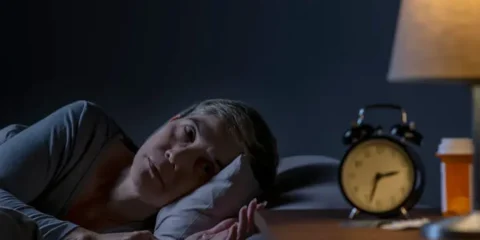Causes, Symptoms, and Treatments
Paroxysmal nocturnal dyspnea (PND) is a condition characterized by sudden attacks of severe shortness of breath and coughing that occur at night. This distressing symptom can significantly disrupt sleep and reduce quality of life.
At Allure Medical, our expert providers are well-versed in properly diagnosing and treating this concerning complaint.
What is Paroxysmal Nocturnal Dyspnea?
Paroxysmal nocturnal dyspnea refers to episodes of severe shortness of breath that awaken someone from sleep. The term “paroxysmal” indicates the sudden onset of these symptoms. PND typically begins about 1-2 hours after initially falling asleep.
Individuals experiencing PND feel an urgent need to sit up or stand in order to breathe comfortably. Remaining lying down exacerbates the sensation of breathlessness.
Along with shortness of breath, PND may also cause wheezing, coughing, and anxiety or a feeling of suffocation. Symptoms normally subside within 15-30 minutes of changing position.
While occasional nighttime breathing troubles can occur in healthy individuals, recurrent PND is not normal and suggests an underlying medical issue.
What Causes Paroxysmal Nocturnal Dyspnea?
PND arises due to a buildup of fluid in or around the lungs. Several different cardiovascular and pulmonary conditions can lead to fluid accumulation and result in PND episodes.
Heart Failure
The most common cause of PND is left-sided heart failure. Heart failure occurs when the heart cannot pump blood effectively. This leads to fluid backup in the lungs, particularly at night while lying down. The fluid buildup causes shortness of breath relieved by sitting upright.
People with left ventricular systolic dysfunction are most likely to experience PND. However, the symptom can occur with preserved ejection fraction heart failure as well. Heart valve abnormalities and damage to the heart muscle can also precipitate heart failure and PND.
Pulmonary Edema
Pulmonary edema refers to fluid accumulation in the alveoli and interstitium of the lungs. It has numerous causes including left heart failure, kidney disease, acute respiratory distress syndrome (ARDS), and more. The extra fluid in the lungs interferes with normal gas exchange and triggers PND episodes.
Pneumonia
Pneumonia leads to inflammation and fluid in the alveoli. This can result in paroxysmal nighttime breathing difficulties. Pneumonia often also causes fever, cough, and abnormal lung exam findings.
Asthma
Asthma is characterized by airway narrowing and mucus production. Symptoms like shortness of breath, coughing, and wheezing typically worsen at night in asthma patients. While not classic PND, nighttime asthma flare-ups disrupt sleep and breathing.
COPD
Some individuals with chronic obstructive pulmonary disease experience increased shortness of breath when lying flat. This resembles PND and relates to impaired lung and chest wall mechanics.
Pulmonary Hypertension
Pulmonary hypertension describes high pressure in the pulmonary arteries. It strains the right ventricle of the heart and can promote fluid retention and PND episodes.
Obstructive Sleep Apnea
Obstructive sleep apnea (OSA) involves repetitive collapse of the upper airway during sleep. This leads to oxygen desaturations that may trigger PND symptoms in some patients. While OSA is more associated with daytime sleepiness, it can also interrupt sleep.
Signs and Symptoms of Paroxysmal Nocturnal Dyspnea
The hallmark symptom of PND is sudden, severe shortness of breath when lying flat that improves upon sitting up. Additional signs and symptoms may include:
- Need to sleep propped up on multiple pillows
- Intense air hunger and feeling of suffocation
- Gasping, labored breathing
- Orthopnea – shortness of breath when lying flat that is relieved by upright positioning
- Sleep disruption
- Anxiety or feeling of dread
- Perspiring
- Wheezing
- Crackles or rales heard on lung exam
- Coughing up sputum or frothy fluid
- Chest tightness or pressure
- Tachycardia
- Swelling in legs or abdomen
PND attacks most often begin within 1-2 hours after initially falling asleep at night. They typically last less than 30 minutes when the individual sits up or stands. Over time, episodes may increase in both frequency and severity.
Diagnosing Paroxysmal Nocturnal Dyspnea
Since numerous conditions can cause PND, a full diagnostic workup is needed. In most cases, a provider will perform a detailed history and physical examination when PND is reported.
They will ask questions to elucidate associated symptoms and medical history. Listening to the lungs can reveal crackles or wheezing. Swollen legs, enlarged neck veins, or abnormal heart sounds may be noted.
Diagnostic testing helps determine the underlying reason for PND:
- Chest X-Ray – Evaluates the lungs and heart for fluid accumulation or other abnormalities
- Echocardiogram – Uses ultrasound to visualize cardiac structure and function
- Pulmonary Function Tests – Assess lung capacity and function
- CT Scan of Chest – Provides detailed images of the lungs to identify pulmonary edema, pneumonia, and more
- Cardiac Stress Test – Analyzes the heart’s response to exertion
- Blood Tests – Measure BNP levels to assess for heart failure. May show impaired kidney or liver function.
- Arterial Blood Gas – Checks oxygen and carbon dioxide levels
- Polysomnography – Overnight sleep study that records breathing and oxygenation patterns
Once test results are obtained, your provider can make an accurate PND diagnosis. This allows appropriate treatment to be initiated that targets the specific cause.
Treatments for Paroxysmal Nocturnal Dyspnea
The appropriate treatments for PND depend on the underlying medical condition responsible.
Heart Failure
Since heart failure commonly precipitates PND, standard therapies for heart failure will be implemented. This includes:
- Medications – Diuretics remove excess fluid while ACE inhibitors and beta blockers reduce strain on the heart. Inotropes may be given for acute exacerbations.
- Dietary Changes – Limiting sodium and fluid intake reduces fluid retention.
- Oxygen – Oxygen administered by nasal cannula helps improve oxygenation.
- Cardiac Devices – Implanted pacemakers or defibrillators may be beneficial in some cases.
- Surgery – Procedures to repair or replace damaged heart valves or revascularize blocked coronary arteries may be performed.
Treating Pulmonary Edema
Strategies to alleviate pulmonary edema causing PND include:
- Elevating the head of the bed
- Oxygen therapy
- Diuretic medications
- Treating the underlying condition like heart failure or kidney disease
- Noninvasive positive pressure ventilation in acute cases
Other Respiratory Conditions
For PND caused by respiratory illnesses like pneumonia, asthma, or COPD the focus is treating the underlying disease. This could involve antibiotics, bronchodilators, corticosteroids, and more.
Positional Therapy
Having individuals sleep propped up on pillows or in a recliner chair can minimize recumbency-related shortness of breath. This allows more comfortable sleep.
NightLase® – An Innovative Snoring and Sleep Apnea Solution
For patients looking to reduce loud snoring and improve obstructed breathing during sleep, Allure Medical offers the revolutionary NightLase therapy. This innovative, non-invasive approach utilizes laser technology to tighten tissue, increase collagen, and open obstructed airways.
Why Choose NightLase?
- Completely non-invasive with no surgery or anesthesia required
- Highly effective at reducing snoring and improving sleep disordered breathing
- Each session only takes 15-20 minutes
- Requires no downtime – resume normal activities immediately
- Provides lasting results for 9-12 months typically
This breakthrough therapy is ideal for those wanting a non-intrusive alternative to CPAP or oral devices. The treatment involves a small handheld device that delivers laser energy to oral tissue. This stimulates new collagen growth and shrinks enlarged tissue that contributes to airway obstruction and snoring.
Patients undergo a series of 3-5 brief treatment sessions spaced 1-2 weeks apart. Improvements in breathing and snoring levels are noticed quickly, with optimal results seen 1-2 months post-treatment.
If you or your loved one deal with bothersome nighttime snoring or have been diagnosed with mild to moderate obstructive sleep apnea, NightLase therapy provides an exciting option to effectively and non-invasively address these issues. Contact us today to learn more and see if you are a candidate. Sleep better tonight with NightLase!
Lifestyle Changes for Paroxysmal Nocturnal Dyspnea
Certain lifestyle modifications can aid in the management of PND:
- Quit smoking
- Follow a low-sodium diet
- Restrict fluid intake
- Take diuretics and other medications as prescribed
- Use supplemental oxygen at night if needed
- Sleep with head elevated
- Increase activity level as tolerated
- Lose weight if obese or overweight
- Avoid alcohol and sedatives before bedtime
- Use breathing exercises and pursed-lip breathing
- Consider cognitive behavioral therapy for associated anxiety
Making these changes promotes better disease control and helps reduce PND episodes. Patients should discuss specific recommendations with their healthcare provider.
When to Seek Medical Care
You should seek prompt medical attention if you experience any of the following:
- Worsening shortness of breath
- Hemoptysis – coughing up blood
- Chest pain
- Wheezing or respiratory distress
- Decreased level of consciousness
- Confusion or slurred speech
- Sudden swelling of legs or abdomen
- Irregular heart rate
These signs could indicate a medical emergency requiring urgent evaluation. Call 911 or go to the nearest emergency room if they occur.
Even if not an emergency, recurrent PND warrants further investigation to determine the cause. New onset or worsening PND should be discussed with your healthcare provider. They can recommend appropriate diagnostic tests and treatment approaches to properly manage this symptom.
FAQs on Paroxysmal Nocturnal Dyspnea?
What is paroxysmal nocturnal dyspnea?
Paroxysmal nocturnal dyspnea (PND) refers to sudden episodes of severe shortness of breath that occur at night during sleep. Attacks of PND cause individuals to wake up gasping for breath and feeling an urgent need to sit or stand up to breathe easier.
What causes PND to happen at night?
When lying flat at night, fluid from the lungs and legs shifts upwards and accumulates in the airspaces of the lungs. This disrupts normal gas exchange and makes breathing difficult, leading to shortness of breath when recumbent.
Is PND serious?
Yes, PND is a serious symptom that requires prompt medical evaluation. It is most commonly caused by acute heart failure. Other potentially life-threatening conditions like pneumonia can also trigger PND. Do not ignore recurrent attacks of shortness of breath at night.
What’s the difference between PND and obstructive sleep apnea?
Obstructive sleep apnea involves repeated pauses in breathing during sleep due to upper airway collapse. This leads to loud snoring, gasping, and daytime sleepiness. PND causes sudden attacks of shortness of breath at night but breathing pauses are not the primary event.
How is PND treated?
Treatment of PND involves managing the underlying condition causing it, such as heart failure, pulmonary edema, pneumonia, etc. Strategies may include diuretics, oxygen, diabetes control, antibiotics, and positional therapy during sleep.
How can I prevent PND episodes?
Steps to help prevent PND include taking medications as prescribed, restricting sodium and fluids, sleeping propped up on pillows, using supplemental oxygen at night, and avoiding alcohol before bedtime. Treating medical conditions like heart failure and kidney disease can also reduce recumbency-related respiratory distress.
Should I go to the ER for PND?
Seek emergency care if you experience chest pain, fainting, excessive coughing, bloody sputum, or struggling to breathe. Call 911 or go to the nearest hospital immediately in these cases of potential respiratory distress. Otherwise, make an urgent appointment with your healthcare provider for evaluation.
Can PND be related to a heart problem?
Yes, the most common cause of PND is acute decompensated heart failure, where fluid builds up in the lungs at night. PND can also result from worsening pulmonary hypertension or valvular heart disease. A cardiology workup is recommended if heart pathology is suspected.
What tests diagnose PND?
Diagnostic testing for PND includes chest x-rays, CT scans of the chest, echocardiography, blood tests including BNP, pulmonary function tests, ECG, cardiac stress testing, and polysomnography. Your provider will order appropriate tests based on your symptoms and health history.
Contact Allure Medical Today
This comprehensive guide covers all key aspects related to paroxysmal nocturnal dyspnea. At Allure Medical, our expert team is here to provide the answers, testing, and treatments you need to resolve this concerning symptom and sleep better at night.
We utilize modern diagnostic capabilities coupled with an integrated approach across specialties including cardiology, pulmonology, sleep medicine, and more. Contact us today to learn more and take control over your health.










